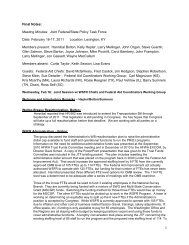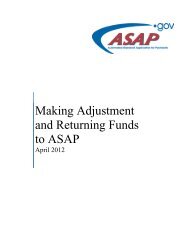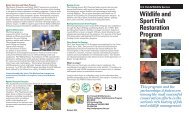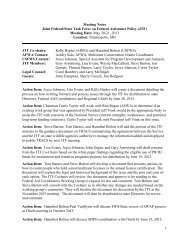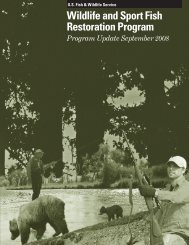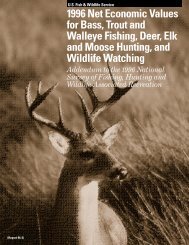Financial Returns To Industry From The Federal Aid - Wildlife and ...
Financial Returns To Industry From The Federal Aid - Wildlife and ...
Financial Returns To Industry From The Federal Aid - Wildlife and ...
Create successful ePaper yourself
Turn your PDF publications into a flip-book with our unique Google optimized e-Paper software.
is appropriated to the state agencies, when the funds are budgeted for a project, <strong>and</strong><br />
when a project is fully implemented. As a result, it can be years between the<br />
manufacture of a product <strong>and</strong> the implementation of a new conservation project.<br />
Perhaps most importantly, investments into conservation projects are often long-term<br />
investments <strong>and</strong> difficult to assess. Rebuilding depleted wildlife populations or<br />
conducting comprehensive habitat improvements can take years or decades to pay<br />
dividends in the form of improved wildlife populations <strong>and</strong> increased hunting activity<br />
which generates sales of products.<br />
Despite these complexities, a multi-tiered approach has been developed to assess<br />
returns to industry. This approach relies on several levels of data analysis:<br />
A macro-level analysis of the growth of the hunting <strong>and</strong> shooting-sports<br />
industries since the initiation of the <strong>Wildlife</strong> Restoration Programs.<br />
<br />
<br />
A fine-scale review of selected case studies (specific projects) that have<br />
utilized <strong>Wildlife</strong> Restoration funding.<br />
A vision of the implications to hunting in the absence of the <strong>Wildlife</strong><br />
Restoration Program.<br />
Although the benefits of a project may be a result of investments from a variety of<br />
funding sources, it is assumed in each case that the <strong>Wildlife</strong> Restoration funding was<br />
vital to the conduct of the projects.<br />
Estimating Return On Investment<br />
<strong>The</strong> “return on investment measure” compares net benefits from the investment to the<br />
costs of the investment. <strong>The</strong> metric is very flexible <strong>and</strong> can be modified by adjusting the<br />
definition of benefits <strong>and</strong> costs. This approach applies the measure at two scales. <strong>The</strong><br />
smaller scale, which is the return to the tax-paying companies from their investment of<br />
the excise tax, is represented by the following equation:<br />
Excise-Tax-Related ROI = [(Wholesale adjusted spending by hunters on<br />
tax-related equipment items) - (Excise-tax-related investments)] /<br />
(Excise-tax-related investments).<br />
<strong>The</strong> benefit to industry is defined as the retail on tax-related equipment items by hunters<br />
<strong>and</strong> shooting sports enthusiasts, adjusted to account for the amount of each sale<br />
passed from retailers <strong>and</strong> wholesalers to manufacturers who pay the tax. An average<br />
mark-up of 30 percent is assumed. 3 Investments are defined as the amount of excise<br />
tax collected (macro analysis) or invested into a specific project (micro analysis). An<br />
Excise Tax-Related ROI is estimated for the nation as whole <strong>and</strong> for each individual<br />
case study.<br />
3 National Sports Shooting Foundation: Annual Retail Survey. Southwick Associates. 2009.<br />
5




